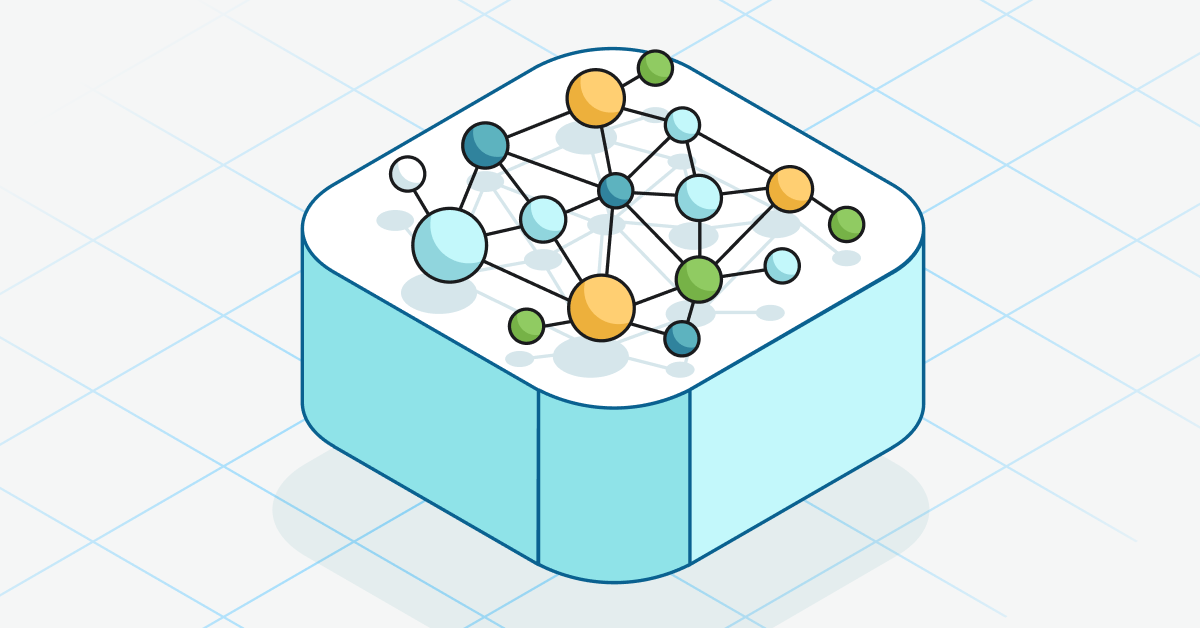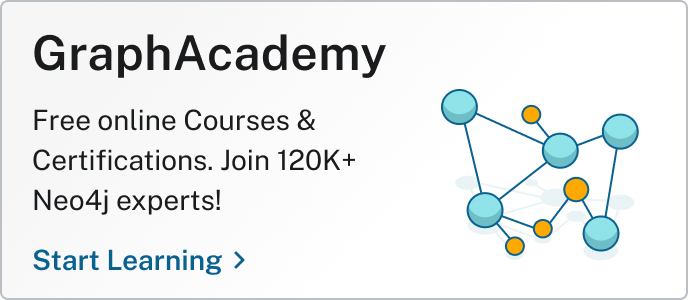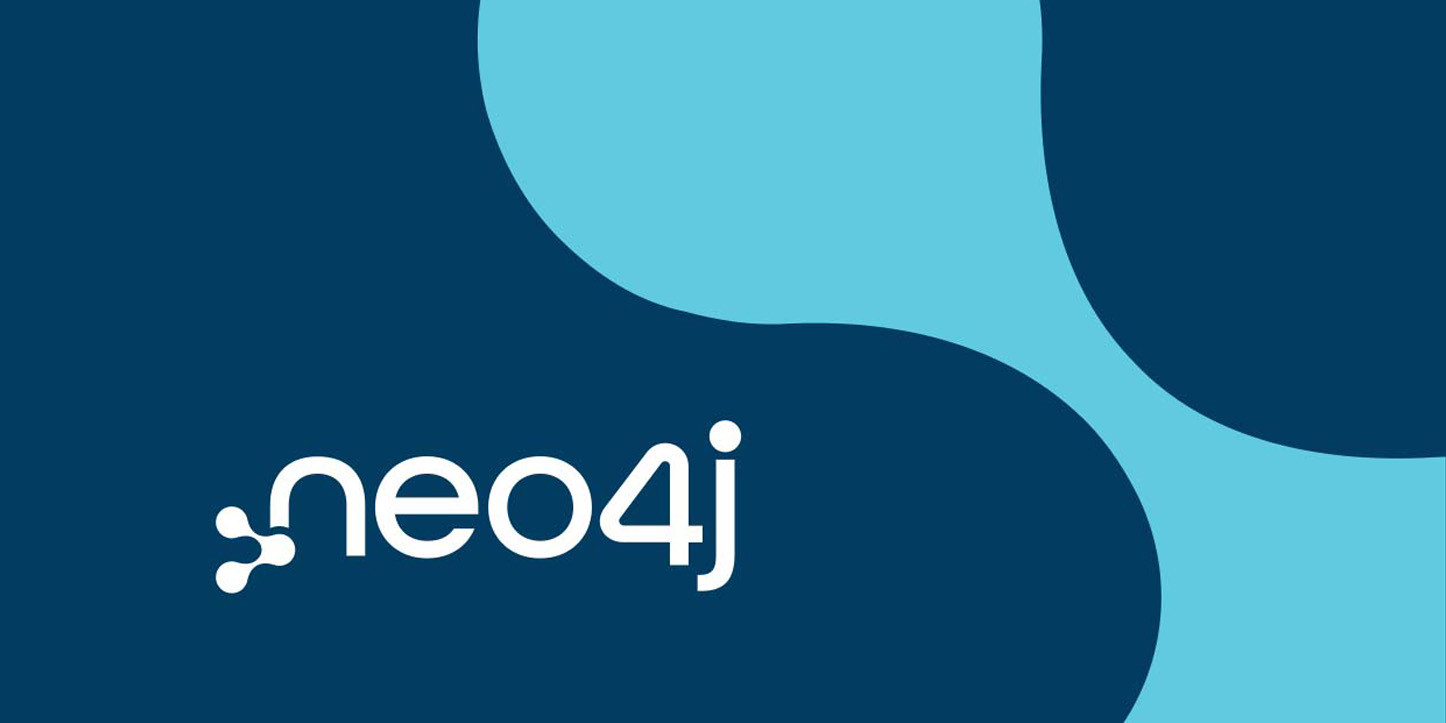
A graph database collects and stores data as a network, foregrounding the connections between data entities. Unlike relational databases, which store data in tables, graph databases are organized around nodes and relationships. Nodes represent entities — a person, place, thing, category, or other piece of data — and relationships represent the connections between nodes. This naturally creates a network structure in the data:

Because most data in the real world belongs to a network, it becomes much more meaningful when we understand how the individual entities in the network relate to one another. If we’re analyzing social media data, we care most about the connections between users. In a graph database, we can use nodes to represent users, and relationships to capture all the social bonds and interactions between them.
The performance advantage offered by graph databases makes them an ideal backend for real-world scenarios where real-time, highly connected data is the rule rather than the exception. As data volumes grow exponentially, it has become increasingly complex, painstaking, and slow to manage the relationships across billions of data entities. More than 80% of the Fortune 100 use Neo4j graph technology in their data stack to solve difficult problems by drawing on the structure of their connected data.
A graph database excels at solving business problems in which the relationships between data entities matter, such as recommendation engines, customer 360, fraud detection, and digital twins like supply chain, transportation, and cybersecurity.

Sometimes, connected data can solve use cases you wouldn’t necessarily expect, like grounding your generative AI application, agentic AI, biotechnical breakthroughs, and anti-money laundering (like the Panama Papers)!
More in this guide:
Understanding the Components of a Graph Database
In a graph database, nodes and relationships can have attributes, which are known as properties. Here’s a look at the key characteristics of nodes, relationships, and properties.
Nodes
Nodes are discrete entities in a graph database that:
- Represent objects or concepts in your domain (people, products, events, etc.)
- Contain properties (key-value pairs) that describe them
- Can be labeled to indicate their role or type (Person, Company, City, etc.)
- Connect to other nodes through relationships
Relationships
Relationships link pairs of nodes to one another and:
- Have a direction (a start node and an end node)
- Have a type that indicates the nature of the connection
- Can hold properties that provide additional context about the relationship
Properties
Properties are attributes of nodes and relationships that:
- Provide descriptive information
- Can be queried and used for filtering
By modeling data in a graph structure with nodes, relationships, and properties, you can represent complex real-world domains. Nodes serve as discrete entities that represent objects in the domain, while relationships represent connections between entities—connections that would, in other types of databases, require reconstruction through JOINs. Properties add crucial context to both nodes and relationships, enriching them with details.
Why Use a Graph Database?
People often use graph databases for application development to reduce or eliminate friction in the development process. The friction caused by non-graph databases can take different forms depending on the project phase, but the reason for it remains the same: There’s a fundamental mismatch between the database structure and the shape of your data. Put simply, the database wasn’t built to support connected data. So how do you know if your database is misaligned to your use case? You will experience friction in your daily work in the following ways:
Design
In the design phase, you spend too much time designing a schema or creating workarounds for a specific use case — even though you know the schema will change and the workarounds aren’t optimal for your next use case. You may also have problems modeling the domain, especially when it involves nested or many-to-many relationships.
When your database aligns with the natural structure of your data, you can design and maintain applications faster and more easily.
Development
The development process becomes overly complex, with lengthy code and workarounds. Since the database you’re working with isn’t designed for complex relationships (many-to-many, for example), you have to use modeling workarounds like reification (in a triple store) or JOIN tables (in a relational database). Predictably, runtime suffers when the code gets overly verbose.
Maintenance
As you maintain the database, you continue to deal with time-consuming, inefficient requirements. You have to rewrite code when relationships change, and you may even have to overhaul the schema entirely when new data and relationships are added.
Graph Databases: Less Code = Less Work
The bottom line is that fewer lines of code means more time to focus on the value you’re trying to deliver with your project. When your database aligns with the natural structure of your data, you can design and maintain applications faster and more easily. And you can focus on solving the business problems you’ve been tasked with, rather than chopping up your data to fit into the rigid shape of relational tables or JSON documents.
Now let’s take a look at relational databases vs. graph databases: What are the major differences, and when should you use each?
Graph Databases vs. Relational Databases
Graph databases and relational databases both store structured data but differ in how they organize and access it. Relational databases have been the dominant model for decades, but ironically, given the word “relation” in their name, they aren’t well-suited for storing and analyzing relationships in data.
A relational database can work well for use cases that require a few fixed JOINS and simple aggregation. “How many widgets did we sell each month last year?” is a good example. Relational database performance degrades, however, when use cases involve larger volumes of highly connected data.

Relational databases must use a JOIN to reconstitute a relationship every time the relationship is needed. Complex queries with multiple or cascading JOINs tend to get exponentially slower as data volume and the number of JOINs increase. Plus, queries have to be kept up to date as relationships change over time.
Graph databases are optimized for relationships — they’re stored in the database itself — so you never have to use JOINs, and application runtime performance won’t degrade as you add connected data.
Relational databases also require significant upfront effort to define the data model before an application can be built, and relational schemas are difficult to update or iterate on when requirements change. A Neo4j graph database, by contrast, uses a flexible graph data model that makes it simple to modify the schema as the use case evolves. (This is not the case for every graph database, such as TigerGraph, Oracle, and Apache Age, for example).
Finally, relational databases can be cumbersome for modeling knowledge domains that involve many-to-many relationships between entities. Graph databases can store and query data with multiple hierarchical or nested relationships with only millisecond latency.
| Relational Database | Graph Database |
| Requires JOIN/intersection tables to represent many-to-many relationships | Natively supports many-to-many relationships in the data model |
| Relationships must be reconstructed using JOINs | Relationships are stored in the database itself — no JOINs required |
| Performance degrades with multiple JOINs as data grows | Maintains performance regardless of data size |
| Schema changes may require a significant redesign | Flexible schema evolves with changing requirements |
| Optimized for structured, tabular data | Optimized for connected, network-like data |
What Is Graph Analytics?
Graph analytics uses graph algorithms to provide deep insights based on the underlying structure of your connected data. It offers more power and flexibility than traditional analytics, without requiring an infrastructure overhaul or specialized expertise. Graph analytics boosts predictive accuracy by 50-80%, far beyond what traditional analytics can achieve.
You can run over 65 prebaked algorithms on your dataset through a cloud-based, serverless platform with Neo4j Aura Graph Analytics. The cloud-based offering makes setup fast by eliminating the need for resource provisioning.
Graph analytics use cases span multiple domains, including:
- Detecting fraud and money laundering patterns
- Tracing disease transmission
- Building a comprehensive Customer 360 view
- Analyzing supply chain disruptions
- Developing recommendation systems
- Understanding social networks
Graph algorithms address core analytical tasks, such as:
- Finding optimal paths
- Identifying communities and clusters
- Ranking nodes by influence or importance
- Predicting likely future connections
- Measuring similarity between entities
- Creating features for machine learning through node embeddings
With support for graph embeddings, the platform translates complex structures into machine learning–ready features. Multi-threaded, in-memory processing delivers results up to 2x faster than open-source tools with zero ETL required.
Essentials of GraphRAG
Pair a knowledge graph with RAG for accurate, explainable GenAI. Get the authoritative guide from Manning.
Graph Database Use Cases
Nearly every data challenge involves connections in data that get lost when you push data into a rigid database structure. Because graph databases efficiently analyze relationships in large, dynamic datasets, they address a broad array of use cases. Here are some of the most common.
Recommendation Engines
A graph database stores and connects users, products, behaviors, and preferences in a network structure to drive personalized recommendations. This relationship-focused infrastructure helps companies process massive amounts of linked data while rapidly delivering high-quality recommendations.
Graph database capabilities like pattern matching reveal similar users and products in real time, enabling the system to adapt as customer preferences evolve. When shopping habits change or browsing occurs in new contexts, the system adjusts without performance degradation.
Fraud Detection
Graph databases help detect fraud by revealing the complex network of accounts, transactions, devices, and behavioral patterns that form a financial ecosystem. This enables institutions to analyze relationships between entities for anomalous patterns. Suspicious transaction pathways emerge naturally when data is structured as a connected graph.
Graph algorithms such as pattern matching, pathfinding, and community detection identify circular money flows indicative of money laundering. Centrality algorithms find accounts that serve as hubs for potentially fraudulent activities. When transaction patterns deviate from established norms, the system flags these anomalies immediately.
Supply Chain Management
Supply chain managers use graph databases to store complex networks of suppliers, raw materials, products, and logistics operations. Having end-to-end visibility into these networks allows managers to identify weak points and predict where disruptions may occur. Graph algorithms, such as shortest path, optimize the supply chain in real time by finding the most direct route between points A and B.
Among the key graph patterns used by supply chain managers:
- Dependency Chain: Captures how entities connect in multi-hop sequences, from suppliers to manufacturers to distributors. A dependency chain traces upstream and downstream relationships to understand how disruptions ripple through interconnected systems.
- Blast Radius: Helps teams trace disruptions like delayed suppliers or failed distributors to identify affected downstream components. It uses variable-length paths to go several hops deep and returns every entity impacted along the way.

- Shortest Path: Finds the most efficient route between entities based on distance, cost, or time. It traverses all intermediate entities to optimize delivery routes, reroute around delays, or calculate cost-effective alternatives.
Customer 360
Organizations use a graph database to capture discrete entities (customers, products, locations, etc.) and organizational hierarchies across business systems. The graph becomes the single source of truth.
Graph traversal algorithms navigate relationships between entities to record lineage and ownership across previously disconnected systems. By mapping how data flows between departments, a graph database functions as a living map of an organization’s information, tracing how data moves between sales, marketing, and other teams. When changes occur in one system, users can follow the connections to understand impacts across the business.
Network and IT Operations
A graph database shows the relationships between infrastructure, applications, and cloud services that support businesses. It can become a digital twin of an organization’s network, giving IT teams complete visibility into dependencies and potential points of failure across hybrid environments.
Understanding dependencies between network components allows organizations to identify root causes when incidents occur. Pathfinding algorithms optimize data flows and resource allocations, ensuring critical services maintain performance even during peak demand.
Generative AI
Graph databases enhance large language models (LLMs) by connecting them to real-time, proprietary, and private information not included in their training data. This approach, known as graph-based retrieval-augmented generation (GraphRAG), addresses significant LLM limitations such as lack of context, outdated information, and unverified responses. Graphs capture the context inherent in data relationships, which helps the application provide more complete and explainable answers.

When an LLM query occurs, a GraphRAG system retrieves relevant information and its connections, enabling responses that include a nuanced understanding of the relationships between entities. This integration produces more accurate outputs with verifiable source data, which is particularly valuable in domains requiring complex reasoning like healthcare and finance.
What Is Graph Query Language?
Graph Query Language (GQL) is designed for querying data stored in graph databases. Unlike SQL, which is optimized for relational data, GQL is tailored to navigate and analyze the intricate relationships between entities in a graph. Neo4j’s query language, Cypher, is the most widely used graph query language and significantly influenced the GQL standard. If you use Cypher, you can be sure your code is compatible with GQL.
Cypher is a declarative query language, meaning your query code focuses on what data you want to retrieve or manipulate, rather than how to perform the underlying operations. This declarative approach simplifies query writing, especially when you’re dealing with complex graph traversals. Instead of writing lengthy SQL JOINs, you can use concise Cypher patterns to describe the relationships you’re most interested in.
If you use Cypher, you can be sure your code is compatible with GQL.
One of Cypher’s strengths is its pattern-matching capabilities. You can represent graph patterns in queries just as you might sketch relationships on a whiteboard. For example, the concept “user A follows user B” can be directly translated into a Cypher pattern, making the code simple and intuitive. This greatly reduces the complexity of querying highly connected data, which in turn allows for faster development and easier debugging.
Furthermore, Cypher offers a rich set of clauses for various operations, including:

- MATCH: Finds and returns nodes or patterns that match the specified criteria.
- CREATE: Adds new nodes and relationships to the graph.
- MERGE: Combines MATCH and CREATE, allowing for “find or create” operations. It first checks if a pattern exists and, if not, creates it.
Cypher’s intuitive syntax and powerful features make it a crucial tool when you’re working with a graph database.
FAQ: Graph Databases
Graph databases provide advantages over other database types, including efficient querying of highly connected data, flexible data modeling, and intuitive representation of relationships. They excel in scenarios where relationships are critical to understanding data.
Graph databases may not be the best choice when data is not highly connected or when simple transactional data is the primary focus. Relational databases may be more suitable in those cases.
Neo4j is a leading graph database platform that offers a native graph engine, scale-out capability, graph analytics, an intuitive data model, a flexible schema, rich data visualization, run-where-you-want deployment options, and a large community of graph experts.
Start Using Your First Graph Database
If your data model is full of relationships and you’re still using a relational or document database, you’re probably wasting time and writing unnecessary code. Graph databases store relationships directly, so you don’t need JOIN tables, nested structures, or brittle workarounds. Model your data the way it actually behaves, and your applications will perform better, even as data complexity grows.
Fire up a free graph instance and follow along with our Neo4j Fundamentals course, or check out our developer’s guide and learn how to create your first knowledge graph.











